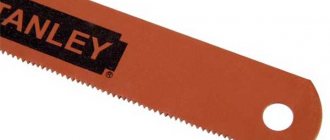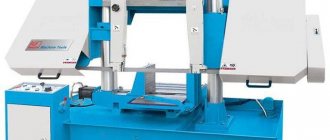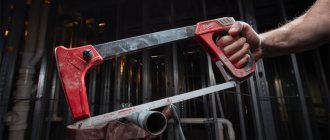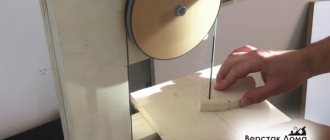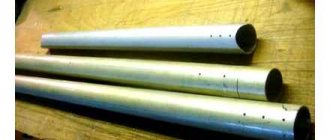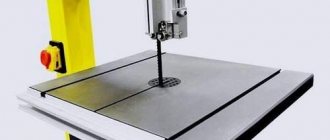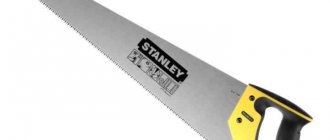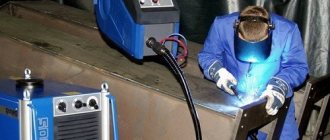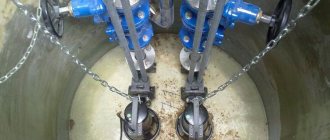Band blades for metal, band saws for metal. HOW AND WHAT DO THEY EAT THEM WITH! Part 1.
In this article I will talk in detail about band saws for metal, all the advantages and disadvantages, how to use them, how to select the tooth pitch, what kinds of saws there are, and much, much more. I’ll give you a bunch of technical information... so first things first...
For modern band saw technologies for metal processing, the market today offers band saws made of carbon steel and bimetallic ones - with a spring base and teeth made of high-speed steel or carbide. The variety of design parameters of band saws in combination with the use of optimal cutting modes makes it possible to ensure high productivity and reduce the cost of the technological process of processing on band saw machines compared to other methods of separation cutting of workpieces.
How to sharpen?
Just like any other tool, the saw needs timely care. The most crucial moment is sharpening the circular saw blades. Experts note that the carbide tooth wears out along the main top edge; if powerful workpieces are sawed, then the side edges also wear out rapidly. The saw should not be allowed to become too dull, because it will be the least productive, and it is not a fact that it is possible to sharpen the discs.
Proper sharpening involves simultaneously ensuring the proper sharpness of the cutting edge. If you sharpen them along one frontal plane, then the number of sharpenings will be less. Many owners of similar tools are interested in how to sharpen a circular saw blade. This depends on the material of the teeth. Sharpening in most cases is carried out on a wheel made of CBN, also called greenish carbide, otherwise based on diamond wheels. CBN wheels are specifically used for sharpening saws made of high-speed steel, and diamond wheels are used for sharpening cutters made of hard alloys. To sharpen quickly, but have less impact on the degree of wear, it is worth choosing diamond wheels with a larger grain size.
For sharpening, machines that have different functionality are also used. The most complex and expensive methods for models provide automatic sharpening. When sharpening, the teeth should be spaced apart: if this is done incorrectly, then at the time of cutting there will be a burning smell, extraneous noise, and the material itself will move jerkily, which is not very comfortable.
The condition of the disks should be constantly monitored, because their wear will increase the load on the mechanisms and at some point lead to complete wear. Thanks to constant sharpening, of course, you can extend the life of the equipment, improve productivity and reduce the time for the cutting process. If after sharpening the cut remains sloppy and the material moves unevenly, it means that you should pay more than just attention to the location of the teeth.
Types of band saws
Band saws made from high-quality high-carbon tool steel are designed for economical cutting of a wide range of alloyed and non-alloyed steels with a tensile strength of up to 80 kPa/mm?, but in terms of their technical and operational indicators they are inferior to bimetallic blades.
The most widely used in modern band saw technology are bimetallic saws, especially with a high-speed steel tooth. The cutting part of the teeth is made of high-speed steel M42 (analogous to 11Р2М10К8). This steel, highly alloyed with molybdenum and cobalt, has high hardness (up to 950 HV) and red resistance. Specially selected spring steel of the saw base provides it with strength and durability, and a reliable electron beam welded connection with the cutting teeth allows these saws to be used in the most difficult production conditions. Saws of a new design with a combined pitch are most suitable for cutting pipes, profiles and workpieces of variable cross-sections. The variable pitch of the saw tooth can significantly reduce vibration, increase the stability and efficiency of the process of cutting workpieces of variable cross-section.
Band blades with carbide teeth are used for the most difficult cutting conditions. They are used on high-performance and rigid double-column band saws for cutting difficult-to-cut materials such as cast iron, non-ferromagnetic alloys, rare earth metals and alloys such as Monel, Inconel, Hastelloy, etc. with high nickel and titanium content, and at the same time significantly reduce the cost of separation cutting . The design of the socket for placing the carbide plate guarantees the strength of its connection with the saw blade. The saw teeth are set, which provides the necessary clearance when sawing and removal of chips. These saws are used for cutting only solid sections with a diameter of 60 mm or more.
Which circular saw is best to buy for your home?
There is a wide selection of circular saw options, reliable and time-tested brands to suit every taste and budget. As a rule, for a person who uses a tool infrequently and for a short time, doing minor repairs in an apartment or country house, a household-grade or semi-professional tool is sufficient.
Using a professional-level circular saw requires a certain skill and ability to handle a technically complex and heavy unit.
In any case, the choice of tool is everyone’s personal choice. Take the instrument in your hands, try it on, feel its weight, read reviews, talk to a consultant in the store - all this will help you make the right choice.
Technical specifications.
To achieve optimal conditions when working with certain groups of materials and the shape of workpieces, it is necessary to accurately select the parameters of the saw blade: pitch, shape and tooth set, as well as operating modes of the band saw machine - speed and feed of the band saw.
Teeth Per Inch (TPI) The number of teeth per inch determines the tooth pitch of the blade and can vary from 1 to 32 for constant pitch saws and from 10/14 to 0.75/1.25 for variable pitch saws. Band saw manufacturers and their distributors provide guidelines for selecting tooth pitch when sawing solid workpieces, pipes and profiles.
| Constant step (for example 14) | Variable pitch (for example 8/12) |
Marking
As you can see in the picture, the markings of the disc can tell about many technical properties. But there is a dependence that should not be ignored: the shape of the teeth directly affects the ability to work with a certain material.
The systematization developed by representatives of the GASS brand divides discs into the following categories according to the shape of the teeth:
GK and GS: alternately beveled. Suitable for processing all types of wood and “clean” chipboards, without plywood and plastic coatings.
GM: straight. They can only cope with cutting soft wood.
GT: trapezoidal. They will be needed in cases where it is necessary to cut MDF or chipboard with lamination.
GR: conical. Cuts multi-layer coatings with double lamination.
GA: trapezoidal and straight. Same abilities as GT.
Wiring
Setting - the inclination or angle of rotation of the tooth relative to the plane of the blade, serves to ensure free movement of the blade and the tooth edge. There are different types of wiring. The standard setting consists of a repeating combination of teeth - right, left and straight. The right-left layout is especially often used for cutting soft materials such as non-ferrous metals, plastic, and wood. “Wave” layout is a special layout for cutting thin-walled profiles, small-diameter workpieces, pipes, etc. Combined wiring is used for cutting pipes, profiles with variable cross-sections and packages.
| Form NORMAL (N). The tooth has a rake angle of 0°. Saws with this tooth shape are designed for cutting alloys with a high carbon content (such as cast iron), for materials with a small cross-section and for thin-walled profiles and pipes. |
| HOOK (H) shape. The tooth has a rake angle of 10°. Saws with this tooth shape are designed for cutting solid bars and thick-walled pipes made of alloy steel. |
| Form RP. The tooth has a rake angle of 16°. Saws with this tooth shape are designed for aggressive cutting of solid bars made of high-alloy steels, difficult-to-cut metals and non-ferrous alloys. |
| MASTER form. The tooth is manufactured in two versions at a rake angle of 10° and 16°. It has a longitudinally ground chamfer, which improves the roughness of the treated surface. Saws with this tooth shape are designed for cutting solid bars made of high-alloy steels. |
Band saw speed.
The cutting mode is determined by several indicators, primarily the workpiece material. It is necessary to take into account which group of steels and alloys it belongs to. You also need to know the size of the workpiece being processed and choose the correct tooth pitch. In this case, what company produced the canvas plays an important role. Sellers of band saw machines provide recommendations for choosing the optimal band saw speed for a specific type of equipment. The equipment produced by the American company JET has proven itself well - models with the VS index are equipped with a stepless speed variator, which allows you to optimally select the cutting speed for a specific group of material. In addition, these machines are equipped with a built-in strain gauge to control the saw tension, which is also important for increasing the service life of the saw.
Determining the feed speed of the saw blade. For optimal cutting, each band saw tooth needs to cut a certain thickness of chips. In practice, the feed is selected according to the recommendations of the equipment manufacturers or according to the type of chips that are produced during cutting. In the case of thin or dusty chips, increase the blade feed speed or reduce the cutting speed. Slightly curling chips indicate that the sawing mode has been correctly selected. Thick or blue chips indicate excessive feed speed or increase cutting speed.
Circular saw tanto.Production process and end.
Circular saw knife
.On the saw there was a mark made in our country and GOST numbers. GOST steel grade
9xf
, and this.
You should choose a saw blade for a circular saw taking into account the type of cut - you will prefer it to be transverse or longitudinal. Even today, the materials you intend to cut also play an important role - wood, plastic, chipboard, non-ferrous metals, pipes... Let us note one thing - any series of discs is designed directly for specific work.
The quality of the blade directly affects the cutting efficiency. A good canvas is created by laser cutting, while balancing is done on a computer. Each disc is sanded separately. A high-quality blade will reflect sanding tool marks when illuminated. If the blade is rough and looks roughly processed, the saw blade for a circular saw will not work efficiently and will soon become dull.
The main reasons for premature failure of the belt web.
A)
- Chipping (knockout) of teeth
- The saw pitch is too small.
- Saw pitch too large.
- The workpieces are not securely fastened.
- Saw speed is too low, resulting in excessive penetration.
- Feed pressure is too high, causing the saw to cut into the material too much.
- Weak saw tension causes it to slip.
- Slipping (stopping) of the saw under load, leading to excessive penetration of the saw into the material.
- The saw cleaning brush is missing, does not work, or is worn out.
B)
- Cracks in tooth cavities.
- Difficult movement of the saw in the guides and pulleys due to contamination of the pulleys or reduced clearance in the guides.
- The gap between the guides is too large.
- The guides are too far from the workpiece.
- The side guides clamp the saw in the tooth gullet area.
- Weak side guides cause the saw to tilt
- Incorrect saw tension.
IN)
- Cracks on the back of the saw.
- Wear of the upper support bearing in the guides
- High supply pressure.
- Wear of side guides.
- The blade is pressed against the pulley collar.
G)
- Beating (vibration) of the saw
- Crooked weld.
- The saw pitch is too much.
- Missing teeth (broken).
- Supply pressure too low or high.
D)
- Premature dulling of teeth.
- The saw speed is too high for the material.
- Saw pitch too small or too large
- The saw blade is not parallel to the feed direction.
- Defects on the side guides.
- The guides are poorly secured or worn.
E)
- Non-perpendicular cut.
- The saw blade is not parallel to the feed direction.
- Large gap in guides.
- The table surface is not perpendicular to the saw.
- The vice is not perpendicular to the saw.
- Low saw tension.
- The side guides are poorly secured.
AND)
- Burnt chips.
- Big serve.
- The saw cleaning brush does not work.
- Dull saw.
- No cooling.
Durability of band saws.
| Material | Productivity, cm/min | Number of blanks, pcs. | The productivity when sawing with bimetallic band saws is in the range of 10-25 cm?/min, when cutting high-alloy alloys and difficult-to-cut materials, and 45-70 cm?/min, when cutting structural steels. For each tool, there is a certain relationship between productivity and durability, which is shown in Table 1. (Data is given for workpieces with a diameter of 100 mm, cut by saws 27x0.9) |
| Steel 20-45 | 40 | 820 | |
| 50 | 780 | ||
| 60 | 660 | ||
| Steel 40Х | 35 | 700 | |
| 45 | 630 | ||
| 50 | 510 | ||
| 20Х13, Р6М5 12Х18Н9Т | 15 | 380 | |
| 20 | 300 | ||
| 25 | 210 |
In addition to the resistance of the saw tooth itself to wear, it should also be noted that the blade itself is resistant to cyclic alternating loads that arise when the saw itself moves in the band feed mechanism of the band saw machine.
For saws from most manufacturers (subject to compliance with the saw manufacturing process - from blank to packaging and storage conditions for the finished blade), the service life of the blade is within 140–160 hours of equipment operation. Removing the saw during breaks in equipment operation for relaxation slightly increases the service life of the blade.
The durability of the saw tooth is significantly influenced by the correctly selected tooth pitch of the band saw. The tables below show the dependence of the saw pitch on the diameter of the material being cut. It should be noted that when cutting with a package, the wall thickness should be considered the total thickness of the metal that the saw tooth will pass through.
What kind of steel are saws made from?
Homemade knives from an ordinary saw
The stores offer a huge selection of knives. They have different designs, purposes, and are made using modern technologies. Today, the materials for production you will prefer are not so much metal, but especially hard ceramics. These knives are very sharp and last a long time.
do not need sharpening, but are quite fragile. Once a chip occurs, it is impossible to restore the knife to its previous appearance, especially on your own.
The blades of the knife are made of hardened steel to make it comfortable to use.
In order for a knife to be pleasant to work with or convenient to cut, it must sit securely and comfortably in the hand. With a comfortable handle, it can be used for a long time. However, it is not often possible to find such a knife in finished form. Then it runs on its own. Here the features of the palm are taken into account, the length is not the shape of the cutting blade. Knives must be made of hardened steel. Therefore, homemade knives from saws will fully meet the requirements.
Content
Knife making options
Homemade knives are made from a variety of metal parts, which, for their intended purpose, are used only because they have become unusable.
Knife handle shapes.
Among the parts where homemade knives are made, there are several:
- worn-out motorcycle connecting rods, where a set of knives of various lengths is made;
- wheel wrenches with one end broken off;
- crutches used when laying rails;
- circular saw blades of different diameters and thickness;
- Damaged pendulum saw blade.
With certain forging skills, a knife is made from a thick metal cable or a chain from a home appliance. A chainsaw is best suited for this purpose. Its chain is quite strong, and the homemade knife will look like Damascus knives.
READ What You Can Cut With a Reciprocating Saw
If the circular saw
has a large disk diameter, and its damage is minimal, then using it you can get two homemade knives.
The discs have significant metal-made strength, since the saw is used for various purposes for a long time
.
Materials and tools
To make a homemade knife, you will need the following equipment:
Graph of knife thickness versus steel hardness.
- Woodworking Machine. If it is not there, then an electric jigsaw is used to pre-cut the handle. For final sanding, sandpaper of different grits is used.
- Nails, in other words, are better than copper wire for rivets.
- Wood.
- The grinding machine does not sharpen. In its absence, use a grinder, hammer drill, or high-power drill. Today, we need attachments, or circles, with the help of which these operations are performed. What steel are the circular saw blades with carbide teeth made from? One of these tools should be firmly secured and work can continue.
- Files with various types of cuts.
- Marker.
- The brass plate will not stick if the handle is not attached with rivets.
- Epoxy adhesive.
HOW TO MAKE A KNIFE FROM A 9HF SAW. Survival knife from an old saw How to make a bushcraft knife
How to make a knife from a saw
.
Making a knife from Soviet steel
. The simplest indestructible survivalist knife.
Knives should have a comfortable handle. The most suitable material for it is wood. The most commonly used are birch and oak blocks. These rocks are the hardest and are less susceptible to moisture during prolonged use. They are pleasant to the touch and have a beautiful texture. Since the manufacture of a knife handle does not require a large amount of starting material, you can use one parquet board, a scrap of board or block for these purposes. It is important that the wooden workpiece is not damaged, cracked or contains chips or other defects.
Once the blade is enough
heated, you need to cool it.
READ Makita Combination Miter Saws Video
In order to make a knife, it is necessary to use certain grades of steel. It should be remembered that the characteristics of the metal depend on how the metal was hardened technologically. For example, as hardness increases, the fragility of metal products increases. Steel grades R6M5 or R3M3F2 are suitable for the knife. In this case, a metal thickness of two mm will be sufficient
.
The strength of a homemade knife does not depend on the thickness of the metal. It is influenced by its geometric dimensions: length, width, shape of the blade and descent. With the right choice of these components and careful processing of the metal, an excellent knife is guaranteed. Such grades of steel are used in the production of disks, blades, and tools such as, for example, a circular saw .
Hacksaw blade knife
If you decide to use a hacksaw blade as a metal blank, then you need to take a blade from a pendulum saw. This saw performs work on thick metal (for example, rails) and meets the requirements for rigidity and strength. The size of such canvases ranges from length/width/thickness, 400-500:30-40:2 mm. The color is determined by the type of manufacturing treatment the saw has undergone and can be black or grey.
Before you start making a knife blade, you need to check the integrity of the metal. This can be done by ear, but this requires some experience and skill. A whole canvas produces a ringing sound, while a damaged one produces a dull sound. If it is difficult to do this by ear, then it is imperative to carefully inspect the metal workpiece.
The outline of the future knife is drawn on a whole piece of canvas with a marker.
The blade angle should be twenty degrees.
Moreover, this should be not only the blade, but also the allowance, which will then be hidden in the handle. After this, on a metalworking machine (or a carefully secured grinder with a circle), it is necessary to gradually and carefully remove the excess.
Do
This should be done slowly, as the metal may heat up. To cool it down and continue working, take a bucket of water. This container should be enough for the workpiece to be placed completely in water. The contours of the blade are made using the same machine. It should be borne in mind that the peculiarity of this steel is that with a sharp change in the temperature of the metal, tiny cracks can form in it. This can lead to the knife breaking even with little force. Therefore, the metal should not be allowed to overheat during its processing. You should be especially careful when cutting the edge, because as the thickness decreases, the metal heats up faster.
READ Saw Chain Parma M
Completing the process: recommendations
After the main part of the metal has been removed, it is necessary to level the straight sections. This is done on the side of the circle. The butt and cutting edge especially need alignment. The angle where the knife blade meets the tail part should not be ninety degrees. This will significantly weaken the entire structure.
A copper or brass rod 4-6 mm is suitable as a rivet. The diameter of the rivet should be smaller than the holes in the shank.
The slopes of the blade must have the same width and angle, and also converge at one point. This will make the knife sharp and easy to sharpen further. When performing descents, it is necessary to constantly cool the metal, stop and check symmetry and accuracy. After this, the blade is ground and polished.
A cut is made on a wooden workpiece using a jigsaw and the outline of the handle is cut out. Having attached the shank, mark the holes and drill them. The shank is coated with epoxy glue and inserted into the slot. Thread a rod through the holes, cut off the excess and rivet it. Exposed glue must be removed before it hardens. The handle is sanded with sandpaper until the handle is smooth.
Source
Saw pitch size for cutting solid steel
| Constant step | Variable pitch | ||
| Diameter, mm | Teeth per inch | Diameter, mm | Teeth per inch |
| to 10 | 14 | up to 25 | 10/14 |
| 10 -30 | 10 | 15 — 40 | 8/12 |
| 30 – 50 | 8 | 25 — 40 | 6/10 |
| 50 — 80 | 6 | 35 — 70 | 5/8 |
| 80 — 120 | 4 | 40 — 90 | 5/6 |
| 120 — 200 | 3 | 50 — 120 | 4/6 |
| 200 — 400 | 2 | 80 — 150 | 3/4 |
| 300 — 700 | 1,25 | 130 — 350 | 2/3 |
| > 600 | 0,75 | 150 — 450 | 1,5/2 |
| 200 — 600 | 1,1/1,6 | ||
| > 500 | 0,75/1,25 | ||
Saw pitch size for cutting profiles and pipes
| Wall S, mm | Outer diameter D, mm | ||||||||||
| 20 | 40 | 60 | 80 | 100 | 120 | 150 | 200 | 300 | 500 | ||
| 2 | 14 | 14 | 14 | 14 | 14 | 14 | 10/14 | 10/14 | 8/12 | 6/10 | |
| 3 | 14 | 14 | 14 | 10/14 | 10/14 | 10/14 | 8/12 | 8/12 | 6/10 | 5/8 | |
| 4 | 10/14 | 10/14 | 10/14 | 8/12 | 8/12 | 8/12 | 6/10 | 6/10 | 5/8 | 4/6 | |
| 5 | 10/14 | 8/ 12 | 8/ 12 | 8/ 12 | 6/10 | 6/10 | 5/8 | 5/8 | 4/6 | 4/6 | |
| 6 | 8/12 | 8/ 12 | 6/ 10 | 6/10 | 5/8 | 5/8 | 5/8 | 5/8 | 4/6 | 3/4 | |
| 8 | 8/12 | 6/10 | 6/ 10 | 6/ 10 | 5/8 | 5/8 | 5/8 | 5/8 | 4/6 | 3/4 | |
| 10 | 6/10 | 5/8 | 5/8 | 5/8 | 5/8 | 4/6 | 4/6 | 3/4 | 3/4 | ||
| 12 | 5/8 | 5/8 | 5/8 | 4/6 | 4/6 | 4/6 | 3/4 | 3/4 | 3/4 | ||
| 15 | 5/8 | 5/8 | 4/6 | 4/6 | 4/6 | 4/6 | 3/4 | 2/3 | 2/3 | ||
| 20 | 4/6 | 4/6 | 4/6 | 3/4 | 3/4 | 2/3 | 2/3 | 2/3 | |||
| 30 | 3/4 | 3/4 | 3/4 | 3/4 | 2/3 | 2/3 | 2/3 | ||||
| 50 | 2/3 | 2/3 | 2/3 | 2/3 | |||||||
When cutting pipes lying next to each other, use values with double the wall thickness
Choosing the ideal saw blades for wood. Find out the characteristics of circular saw attachments.
It doesn't take much to purchase a reliable circular saw. Without good equipment, she will not be able to cope with the assigned tasks. Only the installation of high-quality saw blades will allow you to achieve the highest productivity when working on wood.
Number of teeth
As the number of teeth increases, the processing speed decreases, but the cleanliness of the cut improves. And vice versa: the fewer teeth, the faster the work goes, but the cut becomes less and less careful. The property has its own systematization, presented in the table:
| № | Name | Number of teeth, pcs |
| 1 | Huge | 80-90 |
| 2 | Average | 40-80 |
| 3 | Small | 10-40 |
External diameter
The outer or outer diameter of the disk should not exceed the dimensions of the circular saw casing, otherwise it will not be possible to install it at the landing site. Increasing the parameter leads to an increase in the depth of cut. The line varies from 65 to 500 mm.
Disc thickness
The standard parameter is 3.2 mm. The thinner the disk, the more it heats up and the faster it fails. The large thickness guarantees a long service life of the equipment, but slows down the work. In this case, the excess consumption of material increases due to the wide cut.
Landing diameter
Landing or internal diameter is the size of the hole in the center of the equipment. Determines whether the saw blade will fit on the spindle. The most popular sizes are: 16, 20, 22, 30 and 32 mm. But the full spectrum is even wider - from 11 to 50 mm.
Tooth sharpening angle
The sharpening angle is the angle of difference between the cutting edge of the tooth and the radius of the saw blade. The picture clearly shows how a trait can influence the work process. The angles are:
Standard: 5-15°. Universal sharpening. Suitable for all types of cuts.
Positive: 15-20°. Ideal for rip sawing due to the “grabbing” effect.
Negative: 0 to.5°. Used for cross cutting, does not form chips.
RECOMMENDED CUTTING CONDITIONS ON BAND SAW EQUIPMENT
| Workpiece material | Material designation | Cutting speed, m/min | Cooling | ||||
| DIN | GOST | Special | Bi-metal | Emulsion | Oil | ||
| Yes | No | ||||||
| Structural steels | St 35-St 42 | St 35-55 | 40-55 | 60-80 | 1:10 | X | |
| St 50-St 70 | 30-45 | 50-70 | 1:20 | X | |||
| Hardenable steels | C10-C15 | 45-65 | 60-90 | 1:10 | X | ||
| 14NiCr14 | 30-40 | 40-50 | 1:10 | X | |||
| 21 NiCrMo 2 | 30-45 | 45-55 | 1:10 | X | |||
| 16MnCr5 | 30-45 | 50-65 | 1:10 | X | |||
| Nitrided steels | 34 CrAI 6 | 20-35 | 1:20 | X | |||
| 34 CrAI Ni 7 | 20-35 | 1:20 | X | ||||
| Chrome steels | C 35-C 45 | 35-55 | 55-75 | 1:20 | X | ||
| 41 Cr4 | 40X | 25-35 | 40-60 | 1:20 | X | ||
| 40Mn4 | 40G | 35-45 | 50-65 | 1:20 | X | ||
| 42 CrMo 4 | 40 XM | 30-40 | 35-50 | 1:20 | X | ||
| 36 NiCr 6 | 40 HN | 30-40 | 50-60 | 1:20 | X | ||
| 24NiCr14 | 25-35 | 40-60 | 1:20 | X | |||
| Bearing steels | 100 Cr 6 | 25-35 | 50-65 | 1:30 | X | ||
| 105 Cr4 | ШХ 15 | 25-35 | 50-65 | 1:30 | X | ||
| 100 CrMo 6 | 20-30 | 40-50 | 1:30 | X | |||
| Spring steels | 65Si7 | 65 G | 30-40 | -100 | 1:30 | X | |
| 50 CrV 4 | 50HFA | 30-40 | 40-60 | 1:30 | X | ||
| High carbon tool steels | C80W1 | U8A | 25-35 | 40-55 | 1:30 | X | |
| C125W1 | 20-30 | 35-45 | 1:30 | X | |||
| C 105 W 2 | U10A | 25-35 | 40-50 | 1:30 | X | ||
| Alloyed | 105 Cr 5 | 30-40 | 50-60 | 1:30 | X | ||
| x210Cr12 | X12 | 20-35 | X | ||||
| x 40 CrMoV 51 | 4Х5МФС | 20-30 | 30-40 | 1:30 | X | ||
| x210CrW12 | HVG | 20-30 | X | ||||
| x 165 CrMoV 12 | XM12 | 20-35 | 1:30 | X | |||
| 56 NiCrMoV 7 | 5ХНМ | 25-3 | 20-40 | 1:30 | X | ||
| 100 CrMo 5 | 20-30 | 35-45 | 1:30 | X | |||
| x 32 CrMoV 33 | 20-30 | 30-45 | 1:20 | ||||
| High speed steels | S 6-5-2 | R6M5 | 25-40 | 1:30 | X | ||
| S 6-5-2-5 | R6M5K5 | 25-40 | 1:30 | X | |||
| S 18-0-1 | P18 | 25-40 | 1:30 | X | |||
| S 18-1-2-10 | Р18К10 | 25-40 | 1:30 | X | |||
| Valve steels | x 45 CrSi 93 | 30-40 | 1:20 | X | |||
| x45CrNiW189 | 30-40 | 1:20 | X | ||||
| High temperature steels | CrNi 2520 | 25-40 | 1:10 | X | |||
| x 20 CrMoV 211 | 25-40 | 1:10 | X | ||||
| x5NiCrTi2615 | 25-40 | 1:10 | X | ||||
| Heat-resistant steels | x 10 CrAI 7 | 20-30 | 1:10 | X | |||
| x15CrNiSi25/20 | 20-30 | 1:10 | X | ||||
| x 10 CrSi 6 | 20-30 | 1:10 | X | ||||
| Stainless and Scale-resistant steels | x 5 CrNi 189 | 25-35 | 1:10 | X | |||
| x 10CrNiMoT1810 | 25-35 | 1:10 | X | ||||
| x 10 Cr 13 | 12Х13 | 25-35 | |||||
